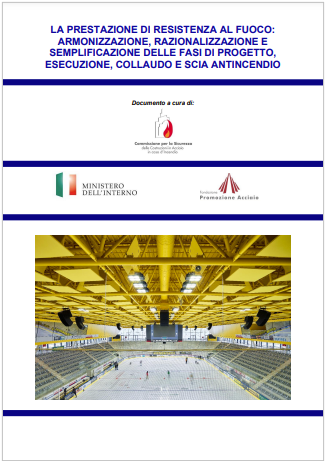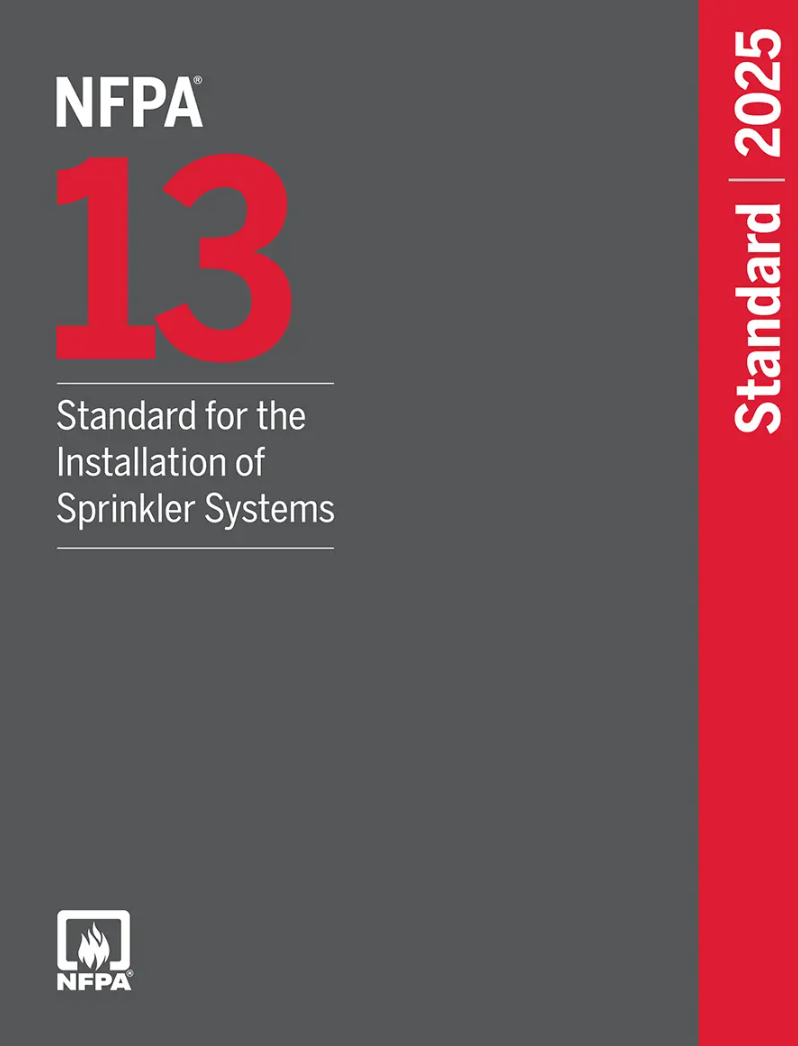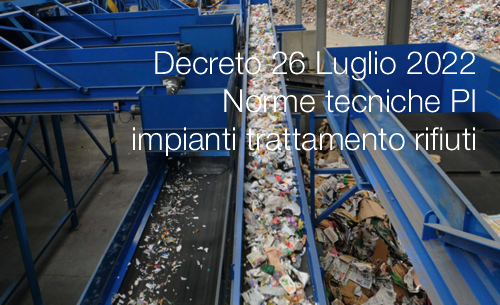Table of Contents
Chapter 1 Administration
1.1 Scope.
1.2 Purpose.
1.3 Application.
1.4 Retroactivity.
1.5 Equivalency.
1.6 Units and Symbols.
1.7 New Technology.
Chapter 2 Referenced Publications
2.1 General.
2.2 NFPA Publications.
2.3 Other Publications.
2.4 References for Extracts in Mandatory Sections.
Chapter 3 Definitions
3.1 General.
3.2 NFPA Official Definitions.
3.3 General Definitions.
Chapter 4 General Requirements
4.1 Level of Protection.
4.2 Basis of Design for the Owner’s Certificate.
4.3 Classification of Hazard.
4.4 System Protection Area Limitations.
4.5 Water Supply Information.
4.6 Additives.
4.7 Air, Nitrogen, or Other Approved Gas.
4.8 Support of Nonsprinkler System Components.
4.9 Noncombustible Materials and Limited-Combustible Materials.
Chapter 5 Water Supplies
5.1 General.
5.2 Types.
Chapter 6 Installation of Underground Piping
6.1 General.
6.2 Piping. [24:10.1]
6.3 Fittings. [24:10.2]
6.4 Connection of Pipe, Fittings, and Appurtenances. [24:10.3]
6.5 Protection of Private Fire Service Mains. [24:10.4]
6.6 Grounding and Bonding. [24:10.5]
6.7 Restraint.
6.8 Steep Grades. [24:10.7]
6.9 Installation Requirements. [24:10.8]
6.10 Backfilling. [24:10.9]
6.11 Testing and Acceptance. [24:10.10]
Chapter 7 Requirements for System Components and Hardware
7.1 General.
7.2 Sprinklers.
7.3 Aboveground Pipe and Tube.
7.4 Fittings.
7.5 Joining of Pipe and Fittings.
7.6 Valves.
7.7 Waterflow Alarm Devices.
7.8 Additives and Coatings.
7.9 Automated Inspection and Testing Devices and Equipment.
7.10 Air Supplies.
Chapter 8 System Types and Requirements
8.1 Wet Pipe Systems.
8.2 Dry Systems.
8.3 Preaction Systems and Deluge Systems.
8.4 Combined Dry Pipe and Preaction Systems for Piers, Terminals, and Wharves.
8.5 Multicycle Systems.
8.6 Antifreeze Systems.
8.7 Outside Sprinklers for Protection Against Exposure Fires (Exposure Protection Sprinkler Systems).
8.8 Refrigerated Spaces.
8.9 Commercial-Type Cooking Equipment and Ventilation.
8.10 Detection and Release System for Preaction and Deluge Systems.
8.11 Vacuum Systems.
Chapter 9 Sprinkler Location Requirements
9.1 Basic Requirements.
9.2 Allowable Sprinkler Omission Locations.
9.3 Special Situations.
9.4 Use of Sprinklers.
9.5 Position, Location, Spacing, and Use of Sprinklers.
Chapter 10 Installation Requirements for Standard Pendent, Upright, and Sidewall Spray Sprinklers
10.1 General.
10.2 Standard Pendent and Upright Spray Sprinklers.
10.3 Sidewall Standard Spray Sprinklers.
Chapter 11 Installation Requirements for Extended Coverage Upright, Pendent, Sidewall Spray Sprinkler
11.1 General.
11.2 Extended Coverage Upright and Pendent Spray Sprinklers.
11.3 Extended Coverage Sidewall Spray Sprinklers. (See 10.2.9.2.)
Chapter 12 Installation Requirements for Residential Sprinklers
12.1 General.
Chapter 13 Installation Requirements for CMSA Sprinklers
13.1 General.
13.2 CMSA Sprinklers.
Chapter 14 Installation Requirements for Early Suppression Fast-Response Sprinklers
14.1 General.
14.2 Early Suppression Fast-Response Sprinklers.
Chapter 15 Installation Requirements for Special Sprinklers
15.1 Open Sprinklers and Open Nozzles.
15.2 Special Sprinklers.
15.3 Dry Sprinklers.
15.4 Old-Style Sprinklers.
15.5 Attic Sprinklers.
15.6 Electrically Operated Sprinklers.
Chapter 16 Installation of Piping, Valves, and Appurtenances
16.1 Basic Requirements.
16.2 Sprinkler Installation.
16.3 Piping Installation.
16.4 Protection of Piping.
16.5 Protection of Risers Subject to Mechanical Damage.
16.6 Provision for Flushing Systems.
16.7 Air Venting.
16.8 Fitting Installation.
16.9 Valves.
16.10 Drainage.
16.11 System Attachments.
16.12 Fire Department Connections.
16.13 Gauges.
16.14 System Connections.
16.15 Hose Connections.
16.16 Electrical Bonding and Grounding.
16.17 Signs.
Chapter 17 Installation Requirements for Hanging and Support of System Piping
17.1 General.
17.2 Hanger Components.
17.3 Trapeze Hangers.
17.4 Installation of Pipe Hangers.
17.5 Pipe Stands.
Chapter 18 Installation Requirements for Seismic Protection
18.1 Protection of Piping Against Damage Where Subject to Earthquakes.
18.2 Flexible Couplings.
18.3 Seismic Separation Assembly.
18.4 Clearance.
18.5 Sway Bracing.
18.6 Restraint of Branch Lines.
18.7 Hangers and Fasteners Subject to Earthquakes.
18.8 Pipe Stands Subject to Earthquakes.
Chapter 19 Design Approaches
19.1 General.
19.2 Occupancy Hazard Fire Control Approach for Spray Sprinklers.
19.3 Special Design Approaches.
19.4 Deluge Systems.
19.5 Design Approaches for Supplemental Sprinklers.
Chapter 20 General Requirements for Storage
20.1 General.
20.2 Protection of Storage.
20.3 Classification of Commodities.
20.4 Commodity Classes.
20.5 Equivalent Storage Arrangement.
20.6 Aisle and Flue Space Requirements for Storage.
20.7 Protection Criteria for Roll Paper Storage.
20.8 High Volume Low Speed (HVLS) Fans.
20.9 Building Construction and Storage: Heights and Clearance.
20.10 Unsprinklered Combustible Concealed Spaces.
20.11 Room Design Method.
20.12 High-Expansion Foam Systems.
20.13 Adjacent Hazards or Design Methods.
20.14 Hose Connections.
20.15 Hose Stream Allowance and Water Supply Duration. (See Section C.8.)
20.16 Discharge Considerations: General.
20.17 Protection of Idle Pallets.
20.18 Column Protection: Rack Storage and Rubber Tire Storage.
20.19 Protection of Racks with Solid Shelves.
Chapter 21 Protection of High-Piled Storage Using Control Mode Density Area (CMDA) Sprinklers
21.1 General.
21.2 Control Mode Density/Area Sprinkler Protection Criteria for Palletized, Solid-Piled, Bin Box, Shelf, or Back-to-Back Shelf Storage of Class I Through Class IV Commodities.
21.3 Control Mode Density/Area Sprinkler Protection Criteria for Palletized, Solid-Piled, Bin Box, Shelf, or Back-to-Back Shelf Storage of Plastic and Rubber Commodities.
21.4 Control Mode Density/Area Sprinkler Protection Criteria for Rack Storage of Class I Through Class IV Commodities.
21.5 Control Mode Density/Area Sprinkler Protection Criteria for Single-, Double-, and Multiple-Row Racks for Group A Plastic Commodities Stored Up to and Including 25 ft (7.6 m) in Height.
21.6 Control Mode Density/Area Sprinkler Protection Criteria for Rack Storage of Group A Plastic Commodities Stored Over 25 ft (7.6 m) in Height for Single-, Double-, and Multiple-Row Racks.
21.7 Control Mode Density/Area Sprinkler Protection Criteria for Storage of Rubber Tires.
21.8 Control Mode Density/Area Sprinkler Protection Criteria for Roll Paper Storage.
Chapter 22 CMSA Requirements for Storage Applications
22.1 General.
22.2 Palletized and Solid-Piled Storage of Class I Through Class IV Commodities.
22.3 Palletized and Solid-Piled Storage of Nonexpanded and Expanded Group A Plastic Commodities.
22.4 Single-, Double-, and Multiple-Row Rack Storage for Class I Through Class IV Commodities.
22.5 Rack Storage of Group A Plastic Commodities.
22.6 Rubber Tires.
22.7 Roll Paper Storage.
Chapter 23 ESFR Requirements for Storage Applications
23.1 General.
23.2 ESFR Design Criteria.
23.3 ESFR Sprinklers for Palletized, Solid-Piled, or Rack Storage of Class I Through Class IV and Group A Plastic Commodities.
23.4 Protection of Exposed Expanded Group A Plastics.
23.5 ESFR Protection of Rack Storage of Rubber Tires.
23.6 ESFR Sprinklers for Protection of Roll Paper Storage.
Chapter 24 Alternative Sprinkler System Designs for Chapters 20 Through 25
24.1 General.
24.2 Sprinkler Design Criteria for Palletized and Solid-Piled, Storage of Class I Through Class IV and Plastic Commodities.
24.3 Sprinkler Protection Criteria for Open-Frame Rack Storage of Class I Through Class IV and Plastic Commodities.
24.4 Hose Stream Allowance and Water Supply Duration.
24.5 Minimum Obstruction Criteria.
Chapter 25 Protection of Rack Storage Using In-Rack Sprinklers
25.1 General Requirements for Ceiling and In-Rack Sprinklers Protecting Rack Storage.
25.2 Protection of Miscellaneous and Low-Piled Rack Storage Using In-Rack Sprinklers.
25.3 Protection of Racks with Solid Shelves.
25.4 In-Rack Sprinkler Protection in Combination with CMDA Ceiling-Level Sprinklers.
25.5 In-Rack Sprinkler Protection in Combination with CMSA Ceiling-Level Sprinklers.
25.6 In-Rack Sprinkler Protection in Combination with ESFR Ceiling-Level Sprinklers.
25.7 In-Rack Sprinkler Protection Options Independent of Ceiling-Level Sprinklers.
Chapter 26 Special Designs of Storage Protection
26.1 General.
26.2 Plastic Motor Vehicle Components.
26.3 Sprinkler Design Criteria for Storage and Display of Class I Through Class IV Commodities, Cartoned Nonexpanded Group A Plastics, and Nonexpanded Exposed Group A Plastics in Retail Stores.
26.4 Special Design for Rack Storage of Class I Through Class IV Commodities and Group A Plastics Stored Up to and Including 20 ft (6.1 m) in Height.
26.5 Control Mode Density/Area Sprinkler Protection Criteria for Baled Cotton Storage.
26.6 Control Mode Density/Area Sprinkler Protection Criteria for Cartoned Records Storage with Catwalk Access.
26.7 Control Mode Density/Area Protection Criteria for Compact Storage of Commodities Consisting of Paper Files, Magazines, Books, and Similar Documents in Folders and Miscellaneous Supplies with No More Than 5 Percent Plastics Up to 8 ft (2.4 m) High.
26.8 Protection of High Bay Records Storage.
26.9 Special Design for Palletized, Solid-Piled, Bin Box, or Shelf Storage of Class I Through Class IV Commodities.
Chapter 27 Special Occupancy Requirements
27.1 General.
27.2 Ignitible (Flammable and Combustible) Liquids.
27.3 Aerosol Products.
27.4 Drycleaning Facilities.
27.5 Spray Applications Using Flammable or Combustible Materials.
27.6 Dipping, Coating, and Printing Processes Using Ignitible(Flammable or Combustible) Liquids.
27.7 Solvent Extraction Plants.
27.8 Stationary Combustion Engines and Gas Turbines.
27.9 Cellulose Nitrate Film.
27.10 Laboratories Using Chemicals.
27.11 Oxygen-Fuel Gas Systems for Welding, Cutting, and Allied Processes.
27.12 Compressed Gases and Cryogenic Fluids Code.
27.13 Utility LP-Gas Plants.
27.14 Production, Storage, and Handling of Liquefied Natural Gas (LNG).
27.15 Information Technology Equipment.
27.16 Telecommunication Facilities.
27.17 Incinerators and Waste and Linen Handling Systems and Equipment.
27.18 Ovens and Furnaces.
27.19 Exhaust Systems for Air Conveying of Vapors, Gases, Mists, and Noncombustible Particulate Solids.
27.20 Class A Hyperbaric Chambers.
27.21 Coal Mines.
27.22 Metal/Nonmetal Mining and Metal Mineral Processing Facilities.
27.23 Fixed Guideway Transit and Passenger Rail Systems.
27.24 Motion Picture and Television Production Studio Soundstages, Approved Production Facilities, and Production Locations.
27.25 Animal Housing Facilities.
27.26 Water Cooling Towers.
27.27 Marine Terminals, Piers, and Wharves.
27.28 Semiconductor Fabrication Facilities.
27.29 Hazardous Materials Code.
27.30 Aircraft Hangars.
27.31 Airport Terminal Buildings, Fueling Ramp Drainage, and Loading Walkways.
27.32 Aircraft Engine Test Facilities.
27.33 Advanced Light Water Reactor Electric Generating Plants.
27.34 Light Water Nuclear Power Plants.
27.35 Cultural Resource Properties — Museums, Libraries, and Places of Worship.
Chapter 28 Plans and Calculations
28.1 Working Plans.
28.2 Hydraulic Calculation Procedures.
28.3 Hose Allowance.
28.4 Hydraulic Calculation Forms and Reports.
28.5 Pipe Schedules.
Chapter 29 Systems Acceptance
29.1 Approval of Sprinkler Systems.
29.2 Acceptance Requirements.
29.3 Instructions.
29.4 Hydraulic Design Information Sign (Hydraulic Data Nameplate).
29.5 Pipe Schedule Design Information Sign (Nameplate).
29.6 General Information Sign.
Chapter 30 Existing System Modifications or Evaluation
30.1 General.
30.2 Components.
30.3 Sprinklers.
30.4 Evaluation of Existing Systems. (AUT-SSD)
30.5 Modification of Existing Systems.
30.6 System Design.
30.7 Testing.
Chapter 31 Marine Systems
31.1 General.
31.2 System Components, Hardware, and Use.
31.3 System Requirements.
31.4 Installation Requirements.
31.5 Design Approaches.
31.6 Plans and Calculations.
31.7 Water Supplies.
31.8 System Acceptance.
31.9 System Instructions and Maintenance.
Chapter 32 System Inspection, Testing, and Maintenance
32.1 General.
Annex A Explanatory Material
Annex B Miscellaneous Topics
Annex C Explanation of Test Data and Procedures for Rack Storage
Annex D Sprinkler System Information from the 2024 Edition of the Life Safety Code
Annex E Development of the Design Approach to Conform with ASCE/SEI 7 and Suggested Conversion Factor Adjustments for Locations Outside the United States
Annex F Limited Area Design and Installation for Existing Residential Buildings for the Purpose of Life Safety
Annex G Informational References


































